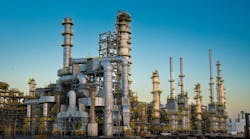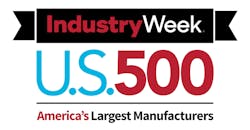$385.4 billion.
That’s more than the total market value of consumer goods giant Procter & Gamble and just a hair below JPMorgan Chase & Co. Or if you prefer a geopolitical ranking, right around the gross domestic product of the Philippines.
No one who visited a gas station last year should be surprised that the energy sector had strong sales and earnings in 2022, but the scale of that success is staggering:
- $1.3 trillion in sales, up 51% from 2021
- $134.6 billion in profits, up 165% from 2021
The Top 5 performers on the 2023 IndustryWeek U.S. 500 list of the nation’s largest publicly held manufacturing companies (ranked by revenue) were all oil and gas producers.
We changed our data collection criteria this year, eliminating names such as Apple, Microsoft and Nike from our list as those companies don’t manufacture products (read more about that here). Without that change, Apple would have been No. 2 and ConocoPhillips (eliminated because it only drills for gas and has no chemicals or refining businesses, unlike ExxonMobil and Chevron) would have been in the low 20s, between Tesla Inc. and Procter & Gamble.
ExxonMobil, Chevron, Marathon, Valero and Phillips 66 all remained in the IW U.S. 500. Without those energy producers, manufacturing profits would have fallen $27.3 billion last year, about 4.9%. With those five included, earnings climbed $77.6 billion or 8.3%.
2023 IW U.S. 500 Coverage
- 2023 IW U.S. 500: Oil & Gas Production Dominate Manufacturing
- The 2023 IW U.S. 500: A Radically Changed List that Asks Which Top Companies Really Manufacture Anything
- PDF Download of the IW U.S. 500 List
- IW U.S. 500 Rejects: Apple, Nike, Hasbro and 68 Other Companies that Don't Make Their Own Products Removed from Manufacturers List
- IW U.S. 500 Rejects List: Companies Pulled from the List Because They Don't Manufacture Products
Textbook Supply & Demand
It was a simple formula: Sell more stuff at a higher price, make more money. Gasoline consumption rose 6.7%, while the average price of a gallon of regular leapt 60% to $3.47 in 2022 from 2021’s $2.17.
Conglin Xu, managing editor, economics, at The Oil & Gas Journal (a publication, like IndustryWeek, owned by Endeavor Business Media), says prices will likely remain high this year “as global demand is ramping up with China’s rebound even more robust than previously expected, and Russian products are likely removed from the market.”
She adds that gasoline supplies could be further cut this year by maintenance needs. Refineries have been running at maximum capacity for more than a year, so producers will eventually have to take them offline to repair and upgrade equipment.
Rising fuel prices were a big driver of inflation, a force that hammered profitability for many manufacturers. Industries that were able to pass along higher costs to their customers performed well, but many others suffered.
Outside of energy, only three business sectors posted 20% or higher sales growth last year:
- Automotive (automakers and suppliers): $512.2 billion, up 23%
- Fertilizers, agricultural chemicals: $57.5 billion, up 29.1%
- Construction materials: $9.6 billion, up 21%
Ford Sinks Auto Profits
Automotive profits would have been stellar last year, gaining around 40.5%, had it not been for Ford Motor Co. (more on that in a bit).
Consumer vehicle research company Cox Automotive reports the average vehicle transaction price in 2022 was $49,507, up 4.9% or $2,297 from 2021. Overall vehicle sales fell 8.2% to 13.7 million, the National Automobile Dealers Association reported, yet the vehicles that companies sold were higher-end, luxury models loaded with expensive options.
S&P Global Ratings predicts that U.S. automotive production won’t get back to pre-pandemic levels until 2025, primarily because there’s no rush. Even with annual sales far below the 17-million-vehicles rate experienced as recently as 2019, producers were highly profitable.
S&P Ratings analyst Nishit K. Madlani, in a research report, says automakers have used a slow, “prudent” approach to restocking empty dealership lots following 2021’s supply chain crises. That disciplined approach gives automakers more control over pricing, avoiding profit-killing cash-back incentives historically used to move the metal. Madlani predicts that automakers will keep 50 to 60 days of inventory on lots this year, down from the 80- to 85-day averages from 2019.
Managing inventory will be extremely important as analysts expect some vehicle demand to decline this year.
“Geopolitical instability, sticky inflation, and the usual delayed impact of tightening monetary policy on consumers’ purchasing power could dampen auto sales momentum in the second half of 2023,” Madlani writes.
Then, there’s Ford.
On a simple, operating measure (revenue from cars sold and financed, minus the costs of making and selling those cars), the leading automaker in terms of revenue had a great year with operating profits up 38.8% to $6.3 billion.
Then come the non-cash, paper losses, mostly related to EV startup Rivian in which Ford was an early investor. In 2021, Ford recorded a $9.2 billion gain in its value, thanks to its shares of Rivian. The reverse was true last year. The windfall Rivian gain from 2021 became a catastrophic $7.5 billion Rivian loss in 2022.
Those write-downs pushed the entire automotive sector to a 43% decline in profitability, despite the strong sales growth.
Inflation’s Impact
As mentioned earlier when discussing oil, rising prices were the story of 2022, and those forces were clear in the performance of the IW U.S. 500. High food prices, for example, meant food industry suppliers had a lot of room to pass along their higher costs. That’s why fertilizer sales were up 29% but earnings jumped 51%.
On the other side, though, were packaged foods producers. At $263.2 billion in sales, that’s one of the largest sectors of the IW U.S. 500, and sales increased 9.3%. Volumes were flat, but higher prices pushed revenues higher.
But, rather than reaping big profits, industry earnings fell a tiny amount ($13 million, about 0.1%) as those price increases simply covered higher costs.
Similarly, apparel sales were about 2% higher, but profits tumbled 15.4%. As HanesBrands Inc. executives put it in their earnings release, “Lower sales volume, unfavorable mix, input cost inflation… more than offset the benefit from higher prices.”
Despite those challenges, manufacturing remained resilient last year. On the 2023 list, 428 companies were profitable last year, with 72 posting losses. Looking at the same 500 companies’ performances in 2021, 449 were profitable, with 51 losing money.




